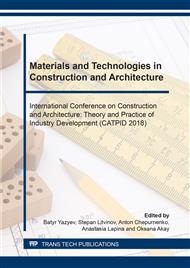p.1220
p.1227
p.1233
p.1238
p.1245
p.1249
p.1255
p.1261
p.1267
Assessment of Construction Project «Pure» Risks
Abstract:
Construction industry has many drivers. The main one is investments. The bigger investment is the more importance takes the assessment of construction production. The investor makes the decision to invest based on assessment of construction production, organisational and technological reliability. The rapid technology and construction management tools development obliges the investor and his team to create new approaches. The article authors propose to consider it in the identification, analysis and subsequent management of pure project risks. Pure risks are defined as risk events, which implementation is clearly negative or has a neutral outcome. Generally the pure risks are not directly related to financial risk events and are not considered as classical approaches of risk management, which adversely affects the construction project prediction. Consideration of the pure construction risks at different stages of building production allows considering the project from the point of view of potential risks. So the investor can quickly make the decision to invest in the project and to assess the possible additional costs of construction, as the construction manager for different production stages would be able to foresee and prevent some risks implementation.
Info:
Periodical:
Pages:
1245-1248
Citation:
Online since:
September 2018
Authors:
Keywords:
Price:
Сopyright:
© 2018 Trans Tech Publications Ltd. All Rights Reserved
Share:
Citation:


